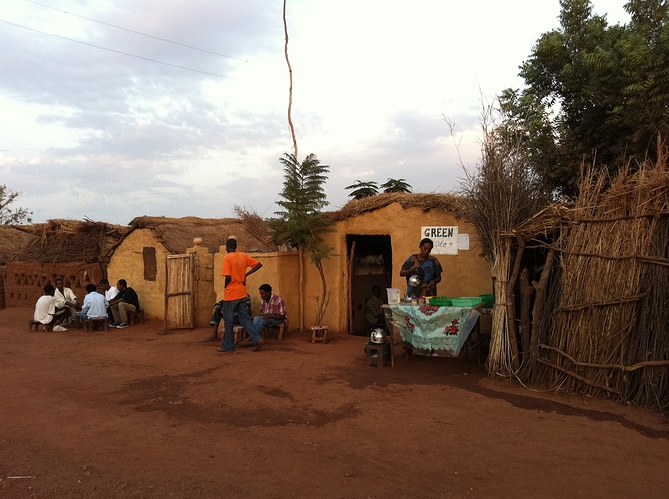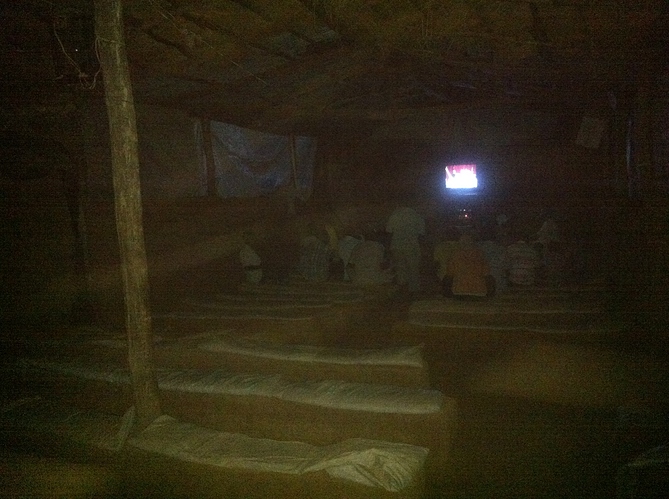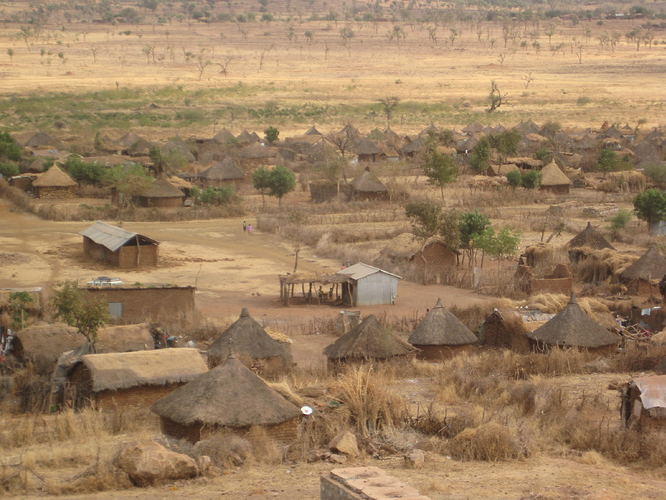REFUGEE HERITAGE CONVERSATIONS
The Coming of Heritage: Shimelba in Time
Anooradha Iyer Siddiqi
Shimelba refugee camp, Ethiopia, 2011. Photos: Anooradha Iyer Siddiqi.
Can I ask why you came to Ethiopia? … A lot of men are being conscripted into the army.
I was not in the army. I was a member of the Ministry of Education. But … in the National Service … there is no salary. Unless you are a fighter. Those who fought for Eritrean liberation … those are eligible for something.
—interview with a Tigrinya refugee in Shimelba camp, Ethiopia, January 17, 2011_
Shimelba refugee camp, Ethiopia, 2011. Photos: Anooradha Iyer Siddiqi.
In Kunama [culture] … the community works together, builds everybody’s house in turns. They built it [her house] that way. For that she had to invite them for meals and drinks, when they were working.
—interview with a Kunama refugee in Shimelba camp, Ethiopia, January 18, 2011 (in translation)
It seems as though the culture hasn’t changed … even though they had a massive displacement.
The Kunama are very stable. They assume it is their homeland. They are economically self-sufficient. Their spirituality is very strong.
—interview with an aid worker in Shimelba camp, Ethiopia, January 17, 2011
Heritage wants narrative. The speech act of narrative implies the disciplining of time: through chronology, pace, periodization, historical consciousness. Conventional notions of heritage demand stable frames of historicity and temporal regimes. Refugee conditions breed plural orders of time and historical frameworks, each with multiplicities of fixity and unsettlement.
Within this paradox, I would like to think the Refugee Heritage proposal in relation to the Shimelba refugee camp: a constructed environment that calls into question the relationship between history and heritage from the temporal vantages of mobility and immobility and concomitant lifeworlds of going and staying. Located on the border of Eritrea some two hundred kilometers from the ruins of the city of Aksum, the seat of an ancient kingdom and a World Heritage site in the Tigray region of Ethiopia— a country that has successfully inscribed nine properties to the UNESCO World Heritage List—this camp meets none of the ten selection criteria for World Heritage. Or, thought differently, it fulfills them all.
I visited the camp in 2011, and would like to consider its constructed environment from the perspective of that moment. In January 2011, Shimelba was on pause: a place of waiting, staying, holding. Its architectural actualization was uncanny amid this temporal dispossession. The camp was all but decommissioned. The UNHCR administrative core had moved on and refugees were being resettled en masse to third countries or to new settlements in Ethiopia, but a few remained, seeing in the economics, traditions, and constructed environments of forced displacement something possible, or emergent.
In spite of its establishment in response to a contemporary war, with access to the humanitarian technologies in wide-scale use since the 1990s, Shimelba was never a tent-city. Its vernacular architecture suggested a defined historical and social order, clear visual and cultural frameworks, and common aesthetic narratives. This is to say: the heritage of Shimelba may be understood as derived from its history of disconnection from external temporal and historical flows—a type of stasis—as well as an acute formal realization of built structures and environmental relationships no longer scheduled to evolve but only to hold still—a mummification of another sort. Shimelba’s architecture—and from that, its heritage—could be said to live in relation to a narrative stillness, the extraction of time from its performance of linearity.
In 2011, the architectural heritage of Shimelba camp could be experienced through an arresting suture of two built fabrics. The first was composed of urbane thoroughfares, street cafes, and cinema houses populated by the highly literate Tigrinya majority—men who fled Asmara to avoid conscription into the war with Ethiopia. These abutted the second: villages of clay granaries, itasena (grass houses), and farms belonging the agrarian Kunama minority who cultivated and greened land that they saw as belonging to them, as part of a contiguous home territory in Ethiopia, Eritrea, and Sudan. These two cultural and architectural realizations appeared distinctly in a site too remote for other forms of development, only to be abandoned after a few years, ostensibly because of political promise elsewhere. Such rupture between the urban and the bucolic has been exploited in a century of garden city movements around the world, and is a legible element in modern architectural heritage—but for an environment putatively constructed under the terms of political foreclosure?
For this question, I wish to consider the problem posed by Refugee Heritage: that the refugee camp must be understood as a “paradigmatic representation of political failure,” to which the “attempt to imagine and practice refugeeness beyond humanitarianism” must attend. While this paradigm and its response may describe conceptual factors for a heritage of the Palestinian camp—and not only Dheisheh—I would argue that they adhere precisely to Palestinian histories and representations, rather than those of all refugee camps, or of Shimelba. They are paradigmatic for the camp that, as “camp,” enacts the refugee right of return, rather than the camp that may become other things—other towns, other villages, other homes. Having said that, I would further argue that the conditions have been foreclosed under which Shimelba, a camp that perhaps need not endure politically as a “camp,” may be understood as a heritage site (even as explicitly fulfilling the universalizing contentions of the World Heritage List). This foreclosure was not engineered by its politics or form, but rather by the conceptual link between heritage, and the universalism it implies, to the camp in Palestine, at the root of the provocation here. A heritage of the Palestinian camp—a camp that cannot not be a camp—must be acknowledged within the heritage of all refugee camps. As the extremity, it contours the body; that is, the histories and representations of a Dheisheh become meaningful to a Shimelba. Following this, I argue that thinking heritage through the paradigm of the camp today—in Africa or elsewhere—demands moving through Palestine, in order to arrive at any other practice of refugeeness beyond humanitarianism.
Shimelba would not exist but for refugees. Nevertheless, a heritage for Shimelba would trace its aesthetic growth and infrastructural evolution quickly from camp to village, beyond refugees and refugeeness. This different refugee heritage was distinguished here in 2011 by the lightened touch of an elsewhere heavy international humanitarian apparatus, and heard in the quiet narratives of the Tigrinya and the Kunama suggested in the excerpts from my interviews above. These do not offer the camp as a representation of political failure, but as a nest for the incubation of other politics and economics, intellectual, pastoral, and liminal.
The promise of an alternative history offered by Shimelba may have been overdetermined by the emergence and persistence of a camp, but not necessarily by the colonial paradigm of occupation. However, in my argument, in order to pose the question of camp as heritage, because Shimelba was a camp during a historical period that included the Palestinian camp means that it is burdened to meet requirements external to its self-conceptualization. It must address the Palestinian referent. Refugee Heritage poses a universal argument. Instead, I would use the example of Shimelba in time to suggest that Dheisheh, as historically and architecturally grounded in the Palestinian colonial, produces a universal standard not for the camp but for the historical narrative of camps—and thus, the attendant understanding of refugee heritage. Put another way: ironically, but necessarily, to get to the refugee heritage of Shimelba, one must pass through that of Dheisheh.
In one sense, this problem would contribute to the ever-eclipsing of the African narrative, reinforcing that it must only exist in relation to others. Moreover, it veils the real possibility that at the time of my visit, Shimelba may no longer have been a refugee camp, and that by then, conceptually, it may have moved on to the forms from which another heritage—refugee or not—might derive. To know this, however, would be to move through and beyond Palestine, in order to move beyond the refugeeness of today’s camps, to the forms of time that, in Shimelba, occasioned going or staying as forms of speech: representing politics, history, and cultural heritage. I would like to offer Shimelba as a heritage site with the understanding that, if its heritage is to be linked to its character as a refugee camp, its history must take into account the terms of colonial occupation, and a history of Palestine’s camps, including the narratives its buildings have represented.
The buildings of Shimelba in 2011 represent narratives, whether or not they were or would be inhabited or abandoned. In camps, buildings may endure, but people wait. Heritage comes both ways.
Anooradha Iyer Siddiqi is a historian of architecture and Fellow at the Harvard University Mahindra Center for the Humanities, and will be joining the faculty of Barnard College, Columbia University. Her research draws from two book projects, Architecture of Humanitarianism: The Dadaab Refugee Camps and Emergency Urbanism in History and Vocal Instruments: Minnette De Silva and an Asian Modern Architecture.



